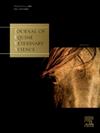Stable microclimates and autonomic modulation in horses housed in different stable architectures during monsoon in a tropical environment
IF 1.6
3区 农林科学
Q2 VETERINARY SCIENCES
引用次数: 0
Abstract
Background
The impact of climate conditions and stable design on horses housed in individual stalls plays a significant role in their well-being, especially in tropical climates. Limited information exists regarding their conditions during the monsoon season.
Objective
This study focused on the stable microclimate and autonomic regulation of horses kept in different stable architectures during the monsoon in a tropical setting.
Methods
Twenty-two horses were assigned to one of three stable designs, each offering unique microclimates, including relative humidity, air temperature, and various levels of noxious gases. Autonomic modulation was assessed by observing multiple heart rate variability (HRV) metrics at one-hour intervals for 24 consecutive hours.
Results
The findings revealed significant variations in stable microclimates across the different designs, with notable differences between day and night. Horses housed in stables with solid external walls and a lower volume-to-horse ratio exhibited lower HRV (p < 0.05-0.0001), indicating more significant stress, compared to those in stables with solid walls and a higher volume-to-horse ratio or those without solid external walls. Furthermore, the study established a correlation between stable microclimates and HRV modulation based on stable design.
Conclusion
These results indicate that autonomic responses vary among horses in different stable designs, suggesting that stable architecture, microclimates, and the volume-to-horse ratio significantly influence horses’ stress responses. Overall, these findings offer important insights for improving housing management to enhance the welfare of horses during the monsoon season in tropical environments.
稳定的小气候和热带环境中不同稳定建筑中马的自主调节。
背景:气候条件和马厩设计对马的影响在它们的健康中起着重要的作用,特别是在热带气候下。有关它们在季风季节的情况的资料有限。目的:研究热带季风季节不同马厩马的稳定小气候及自主调节。方法:22匹马被分配到三个马厩设计中的一个,每个马厩提供独特的小气候,包括相对湿度,空气温度和不同程度的有害气体。通过连续24小时每隔1小时观察多个心率变异性(HRV)指标来评估自主调节。结果:研究结果显示,在不同的设计中,稳定的微气候存在显著差异,白天和黑夜之间存在显著差异。外墙坚固、体马比较低的马厩的马HRV较低(p < 0.05 ~ 0.0001),表明与外墙坚固、体马比较高或无外墙坚固的马厩相比,压力更大。在稳定设计的基础上,建立了稳定小气候与HRV调制的相关性。结论:不同马厩设计条件下马的自主神经反应存在差异,表明马厩结构、小气候和马体比对马的应激反应有显著影响。总的来说,这些发现为改善住房管理提供了重要的见解,以提高热带季风季节马的福利。
本文章由计算机程序翻译,如有差异,请以英文原文为准。
求助全文
约1分钟内获得全文
求助全文
来源期刊

Journal of Equine Veterinary Science
农林科学-兽医学
CiteScore
2.70
自引率
7.70%
发文量
249
审稿时长
77 days
期刊介绍:
Journal of Equine Veterinary Science (JEVS) is an international publication designed for the practicing equine veterinarian, equine researcher, and other equine health care specialist. Published monthly, each issue of JEVS includes original research, reviews, case reports, short communications, and clinical techniques from leaders in the equine veterinary field, covering such topics as laminitis, reproduction, infectious disease, parasitology, behavior, podology, internal medicine, surgery and nutrition.
 求助内容:
求助内容: 应助结果提醒方式:
应助结果提醒方式:


